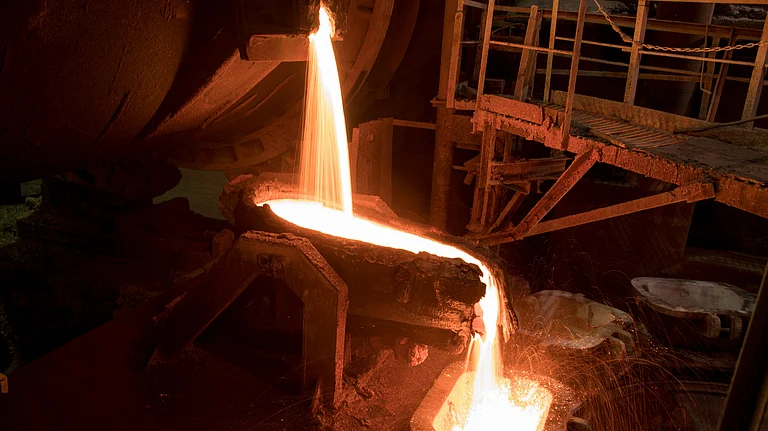Adani Group’s Kutch Copper Ltd has been hit by a global copper supply shortfall.
A report claims that the $1.2 billion plant has received less than one-tenth of the raw material required for efficient operations.
In the ten months to October, the company imported only about 147,000 tonnes of copper concentrate.
Why Adani’s $1.2 Bn Copper Smelter Is Starved of Ore
In the ten months to October, Kutch Copper Ltd imported about 147,000 tonnes of copper concentrate. By comparison, rival Aditya Birla Group’s Hindalco Industries Ltd purchased just over one million tonnes in the same period
Adani Group’s Kutch Copper Ltd has reportedly been hit by a global supply shortfall about a year after starting operations. The unit, which aims to process 500,000 tonnes of copper, began operating in March 2024.
However, according to a Bloomberg report, it has received only a fraction of the raw material required to run efficiently. Citing customs data, the report says the plant, set up with a capital expenditure of $1.2 billion, imported less than one-tenth of the material needed.
In the ten months to October, the company imported about 147,000 tonnes of copper concentrate. By comparison, rival Aditya Birla Group’s Hindalco Industries Ltd purchased just over one million tonnes in the same period, Bloomberg reported.
The smelter in Navinal, Gujarat, needs around 1.6 million tonnes of concentrate to operate at full capacity. BHP Group supplied 4,700 tonnes, while additional shipments came from Glencore Plc and Hudbay, according to customs records.
Global Copper Ore Supply Shortage
The shortage of raw material is not unique to Adani’s new smelter. Copper, valued for its electrical conductivity, ductility and corrosion resistance, is expected to see demand reach about 33 million tonnes by 2035, according to a report by the Centre for Social and Economic Progress (CSEP). The key drivers are renewable energy and electrification.
An 2022 S&P Global study suggests that under a high-ambition scenario with greater mine utilisation and higher recycling, the supply deficit could peak at 1.6 million tonnes in 2035 before easing. Under a business-as-usual scenario, however, the deficit could reach nearly 10 million tonnes by the same year, with demand projected to climb to 53 million tonnes by 2050 against estimated production of 50.4 million tonnes.
Falling ore grades are adding pressure to supply. Global average copper ore grades fell by about 25% between 2003 and 2013. In Chile, grades dropped 30% between 2005 and 2019. Lower grades mean more waste, higher costs, and increased energy and water requirements. Many mines are in water-stressed regions, creating competition with local communities and raising the risk of conflict. Desalination is an option but requires significant capital. Chile and Peru also face seismic risks that could disrupt mining operations.
Ageing mines and infrastructure further complicate supply. More than 200 copper mines are expected to deplete their reserves before 2035, with few large new projects underway, according to CSEP. In Zambia, drought has reduced dam levels, caused power shortages and threatened planned increases in copper output.
Export restrictions add another layer of uncertainty. Governments often impose such measures to protect domestic industries, manage environmental impacts or promote value addition. But when key minerals are concentrated in a few countries, even limited restrictions can disrupt global markets and raise costs for manufacturers. Recent examples include China’s controls on rare-earth technologies, Indonesia’s nickel export ban and restrictions on unprocessed minerals such as lithium in some African nations.
According to Bloomberg, major producers, including Freeport-McMoRan Inc., Hudbay Minerals Inc., Ivanhoe Mines Ltd and Chile’s state-owned Codelco, have faced a wave of mine disruptions this year. China’s rapid expansion of its smelting capacity has added to the supply squeeze.
Where India Stands
CSEP notes that Adani’s Kutch Copper Ltd represents a significant expansion into the metals sector, with a $1.2 billion investment to build a 1-MTPA plant in two phases in Gujarat. The first phase, a 500,000-tonne smelter, was commissioned in March 2024.
A similar capacity will be added in the second phase, expected to be completed by March 2029.
The company is negotiating a supply agreement with Australian miner BHP to purchase up to 1.6 MTPA of copper concentrate valued at around ₹30,000 crore annually, the report says.
The plant will compete with Hindalco and Vedanta. Hindalco’s Birla Copper unit, a private port-based custom smelter with a 500,000-tonne capacity, supplies more than half of India’s refined copper needs. Vedanta’s Sterlite Copper operates a 460,000-tonne port-based smelter, though its 400,000-tonne Tuticorin facility has remained closed since 2018. Hindustan Copper Ltd (HCL), a public-sector integrated producer with a 68,500-tonne capacity, stopped producing cathodes in 2020 and now sells concentrates on the open market, with a major share going to Hindalco under a public–private partnership.

